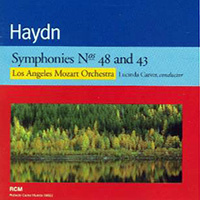 |
| August 15, 2004 Still Discovering Hadyn Along with the Big
Baroque Boom of the 1950s, there was a wholly unexpected reappraisal and revitalization of
a somewhat later composer everyone knew and loved: Joseph Haydn. When it came to
Haydn’s symphonies, we had been familiar with fewer than 20 of the more than a
hundred, and most of those we did know had come down to us in corrupt editions. When the
Haydn Society became active, just after World War II, and H.C. Robbins Landon, one of its
founders, began publishing his research, all this changed very much for the better. The
Haydn Society itself recorded several of the early symphonies most of us had never heard
and never imagined we’d get to hear. Jonathan Sternberg’s unforgettable reading
of No.28 in A major was on the very first H.S. LP. On Westminster, Hermann Scherchen
explored the final 12 symphonies and some gems among the earlier ones. These performances
revealed Haydn’s music with a new depth of emotion, a new brilliance and
imaginativeness in orchestration, and a level of humor that was neither incidental nor
superficial. (All of Scherchen’s monophonic Westminster Haydn may be heard in a
recent six-disc set from Deutsche Grammophon [471 256-2].) Along with the research into
the scores themselves came a new understanding of performance practice (Haydn’s views
on tempo, for instance). Once launched, the Haydn revival (if we may call it that) has
never let up, and there have been some remarkable recordings of the symphonies that
realize the full and authentic glory of the music and also qualify as sonic showpieces. Along with the Big
Baroque Boom of the 1950s, there was a wholly unexpected reappraisal and revitalization of
a somewhat later composer everyone knew and loved: Joseph Haydn. When it came to
Haydn’s symphonies, we had been familiar with fewer than 20 of the more than a
hundred, and most of those we did know had come down to us in corrupt editions. When the
Haydn Society became active, just after World War II, and H.C. Robbins Landon, one of its
founders, began publishing his research, all this changed very much for the better. The
Haydn Society itself recorded several of the early symphonies most of us had never heard
and never imagined we’d get to hear. Jonathan Sternberg’s unforgettable reading
of No.28 in A major was on the very first H.S. LP. On Westminster, Hermann Scherchen
explored the final 12 symphonies and some gems among the earlier ones. These performances
revealed Haydn’s music with a new depth of emotion, a new brilliance and
imaginativeness in orchestration, and a level of humor that was neither incidental nor
superficial. (All of Scherchen’s monophonic Westminster Haydn may be heard in a
recent six-disc set from Deutsche Grammophon [471 256-2].) Along with the research into
the scores themselves came a new understanding of performance practice (Haydn’s views
on tempo, for instance). Once launched, the Haydn revival (if we may call it that) has
never let up, and there have been some remarkable recordings of the symphonies that
realize the full and authentic glory of the music and also qualify as sonic showpieces.
A prime example is a CD from RCM (Rubedo Canis Musica, or Red Dog Music) that is demo class in every respect. I’ve found myself playing it frequently -- to check my system or show it off, or just for the sheer pleasure of it. Like several other "keepers," this disc seems to have been discontinued, but it is definitely worth hunting for. It’s RCM 19602, on which Lucinda Carver conducts the Los Angeles Mozart Orchestra in Haydn’s Symphonies No.48 in C major and No.43 in E flat, and the Overture to his opera Lo speziale ("The Apothecary," after a comedy by Goldoni). The orchestra is not a period-instrument ensemble, but is, on the evidence offered here, a polished and flexible one. Its response to Carver’s vigorous yet (one imagines) smiling direction is both crisp and full-bodied, and the recording itself does everyone proud.
No one has any idea why No.43 is called "Mercury." It has the same scoring as No.48 (except that neither of the horns this time is "in Alt") and there is nothing particularly "mercurial" about it. It is, as Landon points out, a "chamber symphony par excellence," and is characterized more by warmth of heart than by brilliance, though both qualities are abundant. The deletion rate in CD merchandising is as mind-boggling as the volume of the current catalog, and more than a few gems have been dropped that ought never to be out of circulation. That, in part, is what this feature is all about. What RCM 19602 is all about is the miracle of Haydn, which it illuminates with uncommon vividness. ...Richard Freed
Ultra Audio is part of the SoundStage! Network. |
 The opera overture is in the classic
tripartite form of the Italian sinfonia. The robust outer sections might have
bogged down in mere chug-chug in other hands, but here we have an invigorating assurance
of great things to come. About 35 seconds into it there is a brief but delicious comment
from the oboe, standing out just right against the backdrop of strings without holding up
the splendid momentum. The symphonies that follow are extraordinary. No.48 is called the
"Maria Theresia" because of long-held speculation that it was performed when the
Empress visited Eszterháza in 1773. It wasn’t, but the work deserves the imperial
reference anyway. It is one of Haydn’s most dazzling C-major symphonies, with
brilliant parts for the horns. Like so many symphonies of its time, it is scored for an
orchestra comprising only strings and pairs of oboes and horns (with the expectation that
a bassoon might be added as continuo). Some inauthentic scores add trumpets
and drums, and there are recordings that include them, but the fanfares register just as
stunningly without them, perhaps even more so in this beautifully balanced recording.
The opera overture is in the classic
tripartite form of the Italian sinfonia. The robust outer sections might have
bogged down in mere chug-chug in other hands, but here we have an invigorating assurance
of great things to come. About 35 seconds into it there is a brief but delicious comment
from the oboe, standing out just right against the backdrop of strings without holding up
the splendid momentum. The symphonies that follow are extraordinary. No.48 is called the
"Maria Theresia" because of long-held speculation that it was performed when the
Empress visited Eszterháza in 1773. It wasn’t, but the work deserves the imperial
reference anyway. It is one of Haydn’s most dazzling C-major symphonies, with
brilliant parts for the horns. Like so many symphonies of its time, it is scored for an
orchestra comprising only strings and pairs of oboes and horns (with the expectation that
a bassoon might be added as continuo). Some inauthentic scores add trumpets
and drums, and there are recordings that include them, but the fanfares register just as
stunningly without them, perhaps even more so in this beautifully balanced recording.